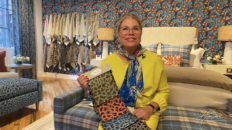By Jennifer Bringle
When placing furniture in your home, there are many things to consider—space available, how it fits with the rest of the room, and whether the color and material makes sense for its surroundings. But perhaps most importantly, it’s critical to pay careful attention to how your furnishings fit into the overall flow of the home.
Creating a sense of flow is a two-fold process—physically making sure the pieces leave plenty of space to move about the home, while ensuring the look of the furnishings and decor maintain a sense of synergy throughout rooms. Here are some strategies for maximizing flow in your home:
Less is More
While it’s physically possible to cram two sofas, a couple of chairs and a coffee table into your small living room, that doesn’t mean you should. Each piece of furniture should have a bit of room to breathe, and it should be easy to walk around pieces, like between the sofa and coffee table. And if you’re short on space, look for pieces that do double-duty, like storage ottomans and benches.
Keep it Moving
One of the biggest mistakes homeowners make when placing furniture is closing off natural paths of movement through the home. You don’t want sofas or tables cutting off the flow of traffic, forcing unnatural turns to navigate around furniture. Likewise, in a dining space, you don’t want to have to skirt awkwardly placed tables or chairs to bring food in from the kitchen.
Maintain Functionality
When outfitting a room, it’s important to keep in mind how the furniture will make it easier to carry out the common activities of that space. In a media room or den, for instance, you want to create clear sight lines to the television. Arrange the sofa parallel to the TV, and angle chairs so the occupants can easily see. In the kitchen, you want to place tables, chairs and other pieces so that it’s still easy to move about while cooking.
Mix it Up
A great way to create visual flow in a space is to vary the style and weight of furnishings. Pair a large, overstuffed sofa with a more dainty end table; add a large wooden chest with a sleek metal bed. You want things that are complementary without being matchy-matchy.
Color Coordinate
Color coordinating doesn’t necessarily mean outfit every room in the same palette or sticking to one shade in individual spaces. It’s more about choosing colors throughout rooms and the overall home that complement each other and tie spaces together with pops of a similar color throughout.For example, a yellow chair with throw pillows in a similar shade on the sofa and a vase in the color in an adjoining room can help tie the spaces together and create a sense of style flow throughout the home.




